

Gyumri, the second largest city in Armenia, has long been a hub for culture and architecture, with its history deeply intertwined with the majestic Black Fortress, also known as Sev Berd. The fortress stands as a sentinel over the past, offering insight into the region's military and cultural heritage.
Built by the Russians in the 1830s during the Eastern War, the Black Fortress was initially constructed to serve as a military base and a defense outpost for the Russian Empire. It was part of a series of fortresses spread across the Caucasus, aimed at consolidating Russian control over the region. Over time, it became a garrison for Russian troops and served as a stronghold during various conflicts, including the Russo-Turkish War.
Originally named "Alexandropol Fortress" after Tsar Nicholas I's wife, the fortress earned its nickname "Black Fortress" due to the dark color of its basalt stones. The fortress has also been part of key historical events, including the tragic 1988 earthquake that shook Gyumri, leading to extensive damage and loss of life.
Tourism in Gyumri, and particularly at the Black Fortress, has evolved gradually as Armenia has opened up to international visitors. Initially, tourism was not a significant focus for the fortress, however, the late 20th century brought about a change in perspective. Gyumri began to embrace its historical and cultural sites as tourist attractions following Armenia's independence from the Soviet Union in 1991.
The restoration of Armenia’s historic sites, including the Black Fortress, began to attract tourists interested in the rich tapestry of the nation's past. The city's fascinating blend of Ottoman, Russian, and Armenian architecture, along with its artistic communities, has highlighted Gyumri as an essential stop for cultural tourism in Armenia.
In recent years, there has been a strong emphasis on cultural and historical tourism, with the Black Fortress being a prominent point of interest. The fortress now hosts various cultural events, including concerts and festivals, which have increased its draw among visitors. Efforts to promote the fortress are part behind-the-scenes tours and exhibits that showcase Gyumri's and Armenia's heritage.
Eco-tourism and adventure tourism have also become popular, with visitors combining their trips to the fortress with hiking in the surrounding areas. Additionally, Gyumri's location on the Silk Road has sparked interest among tourists looking to explore the ancient trade routes.
Furthermore, Gyumri's growing culinary scene has complemented tourism at the Black Fortress, offering travelers a taste of traditional Armenian cuisine alongside their historical explorations. The fortress area has seen the development of cafes and restaurants that integrate local flavors with views of this historical treasure.
In conclusion, the Black Fortress remains one of Gyumri's most iconic landmarks, with a rich history and an evolving role in Armenia's tourism landscape. Its captivating narrative and the city's vibrant culture continue to attract visitors from around the world.